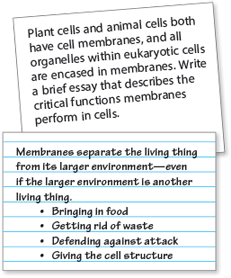Web Page: State Assessment--Unpacking the Writing Prompts
Web Page: How to Dissect a Writing Prompt

Some assessments include writing prompts. You may be asked to write a short response, a paragraph, or a complete essay. Read the prompt and then analyze it by identifying each part of the communication situation surrounding it.
Prokaryotic cells and eukaryotic cells are quite different in structure, size, and complexity. In a few short paragraphs, describe the key differences between these types of cells. (20 percent of exam score)
Prompt Analysis
Sender: Me
Message: Description of differences between prokaryotic and eukaryotic cells
Medium: A few short paragraphs
Receiver: Mrs. Christi
Context: Essay question worth 20 percent of final exam grade
Your Turn Read the following writing prompt and analyze it by identifying the five parts of the communication situation. Remember to indicate both the topic and purpose of the message.
A cell reproduces through mitosis, splitting into two cells. The way the main chromosomes end up in identical cells, however, is different from the way the mitochondrial DNA ends up in both cells. Explain in a brief essay how the main DNA and mitochondrial DNA reproduce. (20 percent of exam score)
A prompt uses purpose words that tell you what you are supposed to do in your response. Watch for these words:
Compare: Show the similarities.
Contrast: Show the differences.
Convince: Change the reader’s mind.
Define: Explain the meaning.
Describe: Use details that clarify.
Evaluate: Show the value or worth.
Explain: Show how something works.
Persuade: Convince through reasons.
Prove: Demonstrate with evidence.
Summarize: Give the main point.
Your Turn Find the purpose words in the two prompts above.
Usually, you will have a limited amount of time to respond to a writing prompt on an assessment. Use a compacted version of the writing process (see pages 212–215) and these tips:

Your Turn Practice writing a response to a prompt. Read the prompt below and analyze it by identifying the five parts of the communication situation, as shown on the facing page. Then write a thesis statement and key support. Pace yourself to write a complete response in 45 minutes.
You’ve considered both objective questions and writing prompts in this chapter. The two approaches test your thinking in different ways. In an essay, explain the challenges of each type of testing approach.
In the response below, note how the student writer has organized the essay into beginning, middle, and ending paragraphs.
Plant cells and animal cells both have cell membranes, and all organelles within eukaryotic cells are encased in membranes. Write a brief essay that describes the critical functions membranes perform in cells.
Beginning paragraph includes a thesis statement.
The biggest organ in our bodies is not the brain. It’s our skin. We may not be used to thinking of skin as something particularly important, but it is. It’s the dividing line between our bodies and the outer world. On the cellular level, a cell’s membrane performs this same function, separating the cell from its larger environment—even if the larger environment is another living thing.
Middle paragraphs focus on key support.
The most important role of the cell membrane is to function as a kind of border patrol. It allows nutrients to enter the cell and provides a way to get waste materials out of the cell. In fact, these functions are so critical that they limit the size a cell can become. Since the surface area of a cell does not increase at the same rate as its volume, eventually a cell reaches a point where its membrane cannot bring in enough food or get rid of enough waste.
Each middle paragraph starts with a topic sentence and includes details.
For single-celled organisms, the cell membrane also helps the cell move through its environment. It may be covered with cilia that flap to move the cell along, or it may have a flagellum extension that moves it along. Amoebas, of course, move along like blobs, with their outer membranes forming pseudopods.
Cell membranes also defend the cell against attack. They prevent alien DNA from entering and make sure that the pH within the cell is correct. Some cell membranes include defensive structures, and some have specific key ports that receive only specific molecules.
Let’s not forget the role of cell membranes in reproduction, either. When cells undergo mitosis, the process begins with the dissolving of the nuclear membrane and ends with the fission of the cell into two cell membranes.
Ending paragraph summarizes thesis.
So, though we may be used to ignoring the bag to focus on the groceries inside it, we ought to remember that the cell membrane performs many valuable functions. In fact, its very existence defines what is living and what is not. That’s a pretty important role for an often ignored structure.
Web Page: State Assessment--Unpacking the Writing Prompts
Web Page: How to Dissect a Writing Prompt
© 2014 Thoughtful Learning
